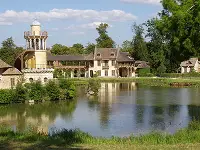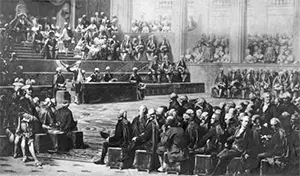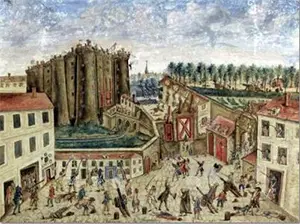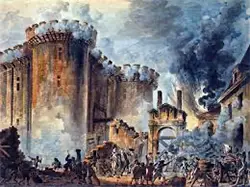The French King Louis XVI
Part 3: The People's Gatherings
Almost from the beginning, a certain element of French society targeted the queen with slander and libel, speaking untruths and half-truths and writing outright lies about the foreign queen and her high-spending ways. This gave rise to her being dubbed "Madame Deficit" and much worse. The more in debt France became–for a variety of reasons that dated all the way back to the treasury-sapping wars of Louis XIV–the more many of the queen's subjects blamed her for the economic struggles that she, as the monarch's wife, was technically overseeing.  Perhaps the height of the disparity between the queen and her subjects came in 1783, when she embarked on a period of construction for Le Hameau de la Reine ("The Queen's Hamlet"), a replica of a farming village that she had built on the grounds at Versailles, the royal palace. Added to a farmhouse and cottages were the trappings of a peasant farming village, even down to a number of animals commonly found on farms at the time. Marie and her maids took to dressing up in peasant clothing and even doing the milking of the cows and sheep. Whatever the queen might have thought about why she was doing such things, the general public, especially the poor, considered her behavior to be mocking those who had nothing other than a farming life to keep them going. Inside the various farm cottages were comfortable furnishings. The king turned next to Étienne-Chaleks de Loménie de Brienne to run the country's finances. One of his primary duties was to convince the parlement to register the king's new laws. By that time, 1787, the king had convened the Assembly of Notables, which had flatly rejected the king's proposals. Louis XVI lashed out, arresting two of the leaders of the opposition, exiling the other members of parlement to Troyes, and then dissolving the body entirely, replacing it with a plenary court. In desperation, the king summoned the Estates-General, which had been dormant since 1614. The name came from the division of French people into three estates by the Ancien Régime. Making up the First Estate were the clergy, the religious leaders of the realm. Nobles and royals excluding the monarch made up the Second Estate. Those two Estates together made up about 2 percent of the population for much of this period. The rest of the population comprised the Third Estate. This included not only commoners and peasants but also slightly wealthier people like businessmen who made respectable but large incomes. The king, in an effort to keep the clergy and nobility in the fold, agreed that the meetings would take place under traditional arrangements. Such arrangements clearly favored members of the First Estate (clergy) and the Second Estate (nobility) but disadvantaged the members of the Third Estate (peasants). Notably and symbolically, the clergy and nobility got to wear their finest clothes while marching into the assembly, whereas the peasants were required to wear plain black clothes. 
Tensions between rich and poor that had been bubbling up for years boiled over at this and other real or perceived slights, and the Third Estate members of the Estates-General demanded double representation. This was significant because the membership in the assembly was not done according to population. The members of the First and Second Estates combined was about 50,000; the Third Estate numbered 25 million. In the 1789 Estates-General, 296 deputies represented the First Estate, 282 represented the Second Estate, and 610 represented the Third Estate. And yet, representation in the Estates-General was equal for each Estate when it came to voting on something, which was the way in which Estates-General worked. So in fact, if the First Estate and Second Estate agreed on something (which they usually did), then they could force its approval, even if the Third Estate did not agree. The government did not grant double representation for the Third Estate. In response, the Third Estate on June 17, 1789 declared itself the National Assembly. The king responded by shutting the doors of the place where the National Assembly had been meeting, and the members of the assembly adjourned to a nearby tennis court, on which they sword the Tennis Court Oath, which bound them to one another and to the common cause of securing for their country a constitution. By this time, a large number of clergy and nobility had found enough in the Third Estate's actions to sign on. On July 9, the National Assembly became the National Constituent Assembly, which officially did away with the Estates-General. In the meantime, Necker, the recently reinstated finance minister, had published the royal financial accounts and the king had, in turn, removed Necker, who was much favored by people from all three Estates, from his position. Public demonstrations on July 12 championed Necker for revealing the king's profligacy. The next day, public gatherings turned violent. 
The violence continued on July 14. Armed protesters had stormed a nearby administrative center, in hopes of obtaining weapons and gunpowder; as it happened, officials there had just a few days before moved their store of 250 barrels of gunpowder to the Bastille. Defending the Bastille were slightly more than 100 soldiers and 30 guns, 18 of which were cannons. The group gathered outside the prison demanded the surrender of the soldiers, their guns and ammunition, and the prison itself. Governor Bernard-René de Launay refused. Negotiations broke out and came to nothing. A few bouts of sporadic gunfire later, the protesters had broken the chains on the drawbridge and stormed into the outer courtyard. Behind the inner gate was the governor, who proposed a cease-fire. At 5:30 p.m., soldiers opened the inner gate and the protesters flooded in, taking control of soldiers, weapons, and the fortress itself, liberating the seven prisoners in the process. 
At no time did the 5,000 Royal Army stationed nearby enter the fray. It was troop movements that sparked the protesters, fearing a crackdown, into more violent action in the first place. The death toll was 103. Only five of those were soldiers: One was the governor, who was killed by the protesters after an angry debate over his fate; one died in the initial fighting; the last were garrison officers killed by the protesters after the fortress had been secured. The following day, the Marquis de Lafayette, who had fought with distinction in the American Revolutionary War, assumed command of the National Guard. In the days that followed, more and more members of the nobility, including the future King Charles X, fled the country. Angry Parisians began dismantling the mighty fortress. Next page > Declaration and Revolution > Page 1, 2, 3, 4, 5, 6 |
|
Social Studies for Kids
copyright 2002–2024
David White



 Complicating matters also at this time was the free-spending proclivities of the queen, Marie Antoinette. She had exorbitant taste and raided the royal treasury to buy expensive clothes and jewelry and to throw elaborate parties. One thing she particularly liked was to have her hair done in extravagant and showy ways. Her hair at times rose a few feet off her head. On one occasion, to mark a French naval victory, she had her hairdo include a large model of a French warship. Her extravagant spending did not go unnoticed, especially by those who could not afford the basics. A series or poor harvests in the 1780s resulted in a rise in the price of bread, which meant that some people had to go without. And yet, Marie, especially, but also others of the royal family and certainly some nobles carried on with their profligate spending. At the same time, however, the queen was known to have given large amounts of food to people in need and even sold off a number of expensive things in her possession in order to buy grain for the poor.
Complicating matters also at this time was the free-spending proclivities of the queen, Marie Antoinette. She had exorbitant taste and raided the royal treasury to buy expensive clothes and jewelry and to throw elaborate parties. One thing she particularly liked was to have her hair done in extravagant and showy ways. Her hair at times rose a few feet off her head. On one occasion, to mark a French naval victory, she had her hairdo include a large model of a French warship. Her extravagant spending did not go unnoticed, especially by those who could not afford the basics. A series or poor harvests in the 1780s resulted in a rise in the price of bread, which meant that some people had to go without. And yet, Marie, especially, but also others of the royal family and certainly some nobles carried on with their profligate spending. At the same time, however, the queen was known to have given large amounts of food to people in need and even sold off a number of expensive things in her possession in order to buy grain for the poor.
